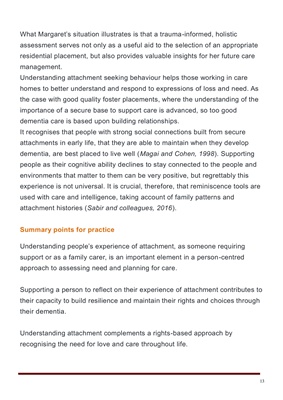
13
What Margaret's situation illustrates is that a trauma-informed, holistic
assessment serves not only as a useful aid to the selection of an appropriate
residential placement, but also provides valuable insights for her future care
management.
Understanding attachment seeking behaviour helps those working in care
homes to better understand and respond to expressions of loss and need. As
the case with good quality foster placements, where the understanding of the
importance of a secure base to support care is advanced, so too good
dementia care is based upon building relationships.
It recognises that people with strong social connections built from secure
attachments in early life, that they are able to maintain when they develop
dementia, are best placed to live well (Magai and Cohen, 1998). Supporting
people as their cognitive ability declines to stay connected to the people and
environments that matter to them can be very positive, but regrettably this
experience is not universal. It is crucial, therefore, that reminiscence tools are
used with care and intelligence, taking account of family patterns and
attachment histories (Sabir and colleagues, 2016).
Summary points for practice
Understanding people's experience of attachment, as someone requiring
support or as a family carer, is an important element in a person-centred
approach to assessing need and planning for care.
Supporting a person to reflect on their experience of attachment contributes to
their capacity to build resilience and maintain their rights and choices through
their dementia.
Understanding attachment complements a rights-based approach by
recognising the need for love and care throughout life.